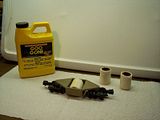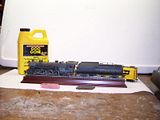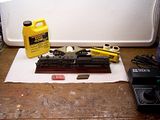They DO oxidize as other metals do, but the [black] oxide film conducts electricity - so it doesn’t interfere with electrical pickup.
That’s what I meant, that the oxide is there but doesn’t pose a problem as far as electrical pickup is concerned.
I think you’re referring to my post above.
The “black gunk” is nickel-silver oxide. Some of it will be there within seconds of cleaning the rails, but the point is, since it conducts electricity, the “black gunk” isn’t keeping your trains from running. If you’re constantly wiping your rails and seeing black gunk and thinking your track is dirty, you’re mistaken. You’ll never eliminate it, nor do you need to. All these products and ideas to keep your rails from oxidizing are holdovers from the days of brass and steel track. Neither of their oxides conduct electricity, so you have to get rid of it.
Give them a rub down with a rag soaked in solvent once in a while to eliminate other crud (dust, mostly) that accumulates on your rails (yes, you will see black stuff on the rag, but most of that isn’t dirt, it’s nickel-silver oxide.
I would only worry about the accumulation of black gunk if you get so much of it that chunks are falling off the rails, or you’ve go so much that you can’t see silver color on the rail heads.
ahh cheers CTValleyRR. Thanks for clearing that up[:)]
Billy,
Just my opinion – by now you know you’ve touched the third rail of model railroad politics here [}:)] [:)] – but my experience is that the black stuff IS Goo Gone, plus some other stuff it picks up and dissolves.
I like to think of it as similar to the scary black oil that kept bubbling up mysteriously in the X Files. Don’t want that stuff around, it’s bad news, if you know what I mean.
Lacquer thinner is a bit too strong for cleaning track. It can dissolve plastic ties, and in fact, any other plastic it gets on. Alcohol is strong enough for track cleaning purposes and won’t attack plastic. Alcohol evaporates completely, which is why it is recommended for cleaning lenses. Or “mineral spirits”, sold in the US as “paint thinner” or “charcoal lighter”. Mineral spirits does not evaporate as cleanly as alcohol, but the slight oily residue it leaves behind is about the same as you get for oiling your track. I have used both alcohol and mineral spirits with good results. But I am about to break out the GooGone for my annual track cleaning exercise.
When I absolutely have to wet-clean track, I use denatured alcohol and a rag. I’ve got an uninsulated garage railroad here in the Central Valley of California, which is known as the Pollen Belt. Goo-Gone just leaves me with sticky pollen on the rails no matter how carefully I wipe it up.
Tom
I’ll agree with you in part, David. Lacquer thinner is strong but it works just fine for cleaning track as long as you are careful and don’t spill any onto the rail ties and rail holders. I use mine with a CMX cleaning car and a proper drip rate and it evaporates quickly.
Tom
Sure, when you do your monthly track cleaning, some of the black stuff that ends up on the rag is dirt and other junk, but MOST of it is oxide off the rails. The only way to eliminate this is to remove the rails, and that kind of defeats the purpose.
Billy21: I posted this several years ago to show how I clean my wheels and track with the “Goo”. Some were ok with it others not so much. I have use it for a long time and it works. I always wipe my track clean after using it.
 This the cleaning car that can be purchased with the GOO.
This the cleaning car that can be purchased with the GOO.
The other substance that I us is Automatic Transmission fluid and that works very well, again I wipe the tracks clean, I also use it to clean wheels as well. Chuck Hitchcock of Argentine fame has talked about using LaBelle 101 oil that seems to improve conductivity of the tack; it works well to. Not so much for cleaning ut to improve the electrical contact.
This may help.
Robert Sylvester, WTRR

